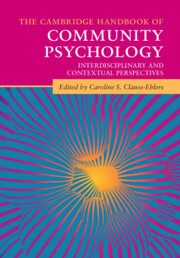Book contents
- The Cambridge Handbook of Community Psychology
- The Cambridge Handbook of Community Psychology
- Copyright page
- Dedication
- Contents
- Figures
- Tables
- Contributors
- Foreword
- Part I Foundational Concepts
- Part II Research, Assessment, and Program Evaluation
- 6 Conducting Culturally Responsive Community Needs Assessments
- 7 Comprehensive Evaluation of a Rural School Mental Health Program
- 8 Constructive Diversity Pedagogy for Challenging Classroom Dialogues
- 9 Critical Language Ethnography as a Community-Centered Research Paradigm
- Part III Community Psychology in Action
- Part IV Where Do We Go from Here?
- Index
- References
9 - Critical Language Ethnography as a Community-Centered Research Paradigm
from Part II - Research, Assessment, and Program Evaluation
Published online by Cambridge University Press: 16 December 2021
- The Cambridge Handbook of Community Psychology
- The Cambridge Handbook of Community Psychology
- Copyright page
- Dedication
- Contents
- Figures
- Tables
- Contributors
- Foreword
- Part I Foundational Concepts
- Part II Research, Assessment, and Program Evaluation
- 6 Conducting Culturally Responsive Community Needs Assessments
- 7 Comprehensive Evaluation of a Rural School Mental Health Program
- 8 Constructive Diversity Pedagogy for Challenging Classroom Dialogues
- 9 Critical Language Ethnography as a Community-Centered Research Paradigm
- Part III Community Psychology in Action
- Part IV Where Do We Go from Here?
- Index
- References
Summary
This chapter develops a critical language ethnography approach to community-based research. The authors propose that this approach can offer rich qualitative insights into those everyday interactions through which children and adults acquire and impart locally accepted norms for language use in their communities while also co-constructing social identities and collective practices that can resist and change oppressive structures. The chapter reviews ethnographic projects that work not only to depict the cultural underpinnings of community life but that also seek to disrupt those structural forces that produce inequities across communities. By integrating insights from the fields of Language Socialization (LS) and Critical Ethnography (CE), the authors seek to bring into conversation complementary subfields within anthropology, sociolinguistics, and education that share a commitment to community-centered research. The chapter is organized thematically around three themes of power, praxis, and positionality and it provides a critical case analysis to illustrate the ways in which a critical language ethnography can be used to analyze everyday interaction in communities.
- Type
- Chapter
- Information
- The Cambridge Handbook of Community PsychologyInterdisciplinary and Contextual Perspectives, pp. 175 - 196Publisher: Cambridge University PressPrint publication year: 2021



